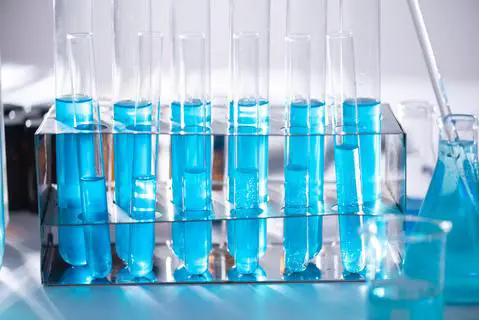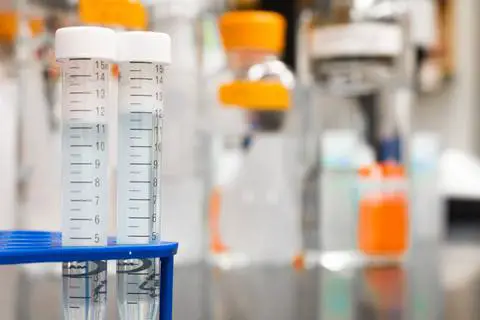A cup of coffee may initially seem simple: two ingredients – water and ground coffee. However, this doesn’t tell the whole story. Even assuming the use of distilled (pure) water, ground coffee has over 1,000 chemical compounds, most of which are extracted by water during brewing. Depending on where the coffee came from, how it was processed, and how it was roasted, these compounds may or may not be present in your cup and may differ in quantity.

Let’s consider several of the more common coffee compounds- what they are, what effects they have when ingested, and their role in producing a great cup of coffee.
Basic Coffee Chemistry
First, let’s introduce some basic chemistry concepts related to coffee:
Aldehyde: An organic compound that contains carbon, hydrogen, and oxygen.
Alkaloid: A class of organic compounds that originate in plants that have physiological effects on a person; caffeine, serotonin, and so on.
Caramelization: A chemical reaction facilitated by heat which breaks down sugar molecules and results in different compounds.

Furan: These are heterocylic organic compounds that consist of a five membered aromatic ring, which play a key role in the scent of coffee.
Maillard Reaction: A chemical reaction between amino acids and reducing sugars, in which heat is used as a catalyst. Think of the browning on a steak, or in this case, coffee roasting.

Non-Polar Molecules: These have an even number of electrons and protons, which results in a more stable molecule. A brewed cup of coffee contains 10-25% non-polar compounds.
Non-Volatile Compounds: These are compounds that remain stable at room temperature, and are able to impact flavor and mouthfeel.
Polar Molecules: These molecules have an uneven number of electrons and protons, which results in a higher electronegativity. Polar molecules also dissolve easier in other polar molecules. Think of magnets, water, ammonia, etc. A brewed cup of coffee is between 75% and 99% polar compounds.
Reducing Sugar: A reducing sugar is a sugar that has a free aldehyde or ketone group, which have an oxygen atom joined to a carbon chain with a double bond. The composition of these sugars allows for them to easily break down or pair with other molecules.
Volatile Compounds: Organic compounds that evaporate at room temperature. Volatile compounds are directly related to scent. Chances are, if you can smell it, it is volatile.
Chemical Compounds Affect Both Flavor and Aroma

When it comes to flavor and aroma, a huge variety of compounds contribute to what most people perceive as a classic coffee flavor/aroma. The classic brewed coffee aroma specifically results from over 900 different volatile compounds.
What Chemical Compounds Affect Coffee Aroma?
Let’s consider the following 12 with the greatest contribution most to coffee aroma:
2-furfurylthoil (Sulfur Containing): Even in isolation, this compound smells a lot like roasted coffee.
3-methyl-2-buten-1-thiol (Sulfur Containing): Sulfurous smell, with a hint of ammonia
3-mercapto-3-methylbutylformate (Sulfur Containing): Smells a little like caramelized onion, roasted coffee, sulfur, and meaty.
Methanethiol (Sulfur Containing): Smells like rotten cabbage.
Methylpropanal (Aldehydes/Ketones): One of the better smelling compounds on this list, Methylpropanal smells both floral and spicy.
3-methylbutanal (Aldehydes/Ketones): A fruity and malty smell.
Acetaldehyde (Aldehydes/Ketones): Acetaldehyde A pungent yet fruity aroma.
(e)-β-damascenone (Aldehydes/Ketones): Smells of honey yet also fruity.
Guaiacol (Phenolic): Guaiacol Tends to smell quite smoky and spicy; more prevalent in darker roasts.
Furaneol: (Furans): This compound smells sweet with notes of caramel; also more prevalent in darker roasted coffee.
2-isobutyl-3-methoxypyrazine (Pyrazines): A distinguishable earthy aroma.
2-ethyl-3,5-dimethylpyrazine (Pyrazines): Also earthy, but with roasted notes.
While some of these compounds might seem a bit displeasing, such as the sulfurous ones, they form an aroma greater than the sum of its parts when combined.

What Physiological Effects does the Aroma of Coffee Have?
A study conducted involved the use of key compounds created in a lab used to create synthetic coffee. Expert coffee tasters were then asked to detect oddities within the synthetic brew. The researchers found that the lack of certain compounds can’t even be noticed by a trained nose and tongue.
While on the topic of aroma, there are also studies that show a potential correlation between simply smelling coffee and brain activity. However, these studies were performed on sleep deprived rats, so its unclear to what degree the results are applicable to humans.
Additionally, a study was conducted involving two groups of people each given an exam, with one group in a room smelling of coffee, with the other group being a control group. The former group, in which the room smelled of coffee, scored higher on the exam. However, the extent to which coffee’s aroma is beneficial is still debated, with quantifiable evidence still lacking.

What Chemical Compounds Affect the Taste of Coffee?
Regarding the flavor of coffee, roasting is likely the most impactful step in determining the eventual taste of your cup. This is primarily due to two factors: the Maillard reaction and the process of caramelization, each facilitated by the chemical composition of the coffee beans.
The Maillard reaction consumes amino acids and reduces sugars to produce melanoidins, resulting in the familiar brownness and body of brewed coffee. The breaking down of these compounds produces hundreds of separate compounds that contribute to both flavor and aroma. Additionally, keeping the beans in the Maillard reaction phase for a longer duration of time – like while making a dark roast – results in a less acidic but also less fruity/sweet profile, as most of the compounds that produce these notes are destroyed. The inverse of this is true as well; a short Maillard reaction results in a sweeter and more acidic profile.

Listed below are a few key compounds that have an outsized role in dictating the flavor of coffee:
1,3,7-trimethylpurine-2,6-dione (Caffeine): While it is widely debated what impact caffeine has on the taste of coffee, isolated caffeine is quite bitter, so perhaps some of that bitterness contributes to the bitterness of brewed coffee. Coffee with less caffeine is generally less bitter than coffee with a higher concentration of it, but it is unclear to what extent this is due to the amount of caffeine (correlation vs. causation). Consider robusta beans vs arabica beans: the former is known to be more bitter, with higher caffeine content. Caffeine has an incredibly wide variety of effects on the body, both good and bad, but most recognize caffeine as the source of their morning energy.
5-caffeoylquinic acid: Roasted beans contain several acids falling into this category, a number of which directly contribute to bitterness. The concentration of these acids decreases, however, for longer roasting processes. Through the Maillard reaction, quinolactones, phenylindanes, and melanoidins are produced. Melanoidins are particularly bitter.
Citric Acid: Citric acid is very prevalent in green coffee beans, but roasting causes citric acid to break down, limiting the amount that ends up reaching your cup. This is why dark roasts are significantly less acidic than light roasts. Citric acid has antioxidant properties, and contributes to what people would call a “bright acidity” in taste profile.

Sucrose: Sucrose is a common sugar found in a variety of foods. In coffee, the amount decreases from green bean to roasted bean- ranging from 7.3% for an unroasted bean from particular origins down to 0.3% for a very dark roast. Sucrose is responsible for slight sweetness of black coffee.
Lipids/Fats: Surprisingly, due to the Maillard reaction, the amount of oils present in coffee increases from green to roasted: 11.4% to 11.9%. The oils present greatly impact mouthfeel, as they linger on the tongue far longer than water, contributing heavily to the great texture and taste a French press produces.
Maleic Acid: This acid is usually responsible for a sour, sharp, but fruity taste that is normally accompanied by a degree of astringency. Additionally, it is produced naturally within the human body as carbohydrates are digested and converted into energy. Some say that applying maleic acid to the skin can reduce aging artifacts and remove dead skin cells, while consuming it increases collagen production.
Ethanoic Acid/Acetic Acid: Contributing to a sour profile with notes of white vinegar, it has several uses in household cleaning and is used to make glue. Also listed by the World Health Organization as an essential medicine.
Nicotinic Acid: Commonly known as both niacin and Vitamin B3, nicotinic acid is produced in the roasting process only at times that the roasting temperature exceeds 160 degrees Fahrenheit (71 C). At 160F, a methyl group detaches from a different compound, releasing nicotinic acid. Nicotinic acid is water soluble, meaning that it is easily extracted from ground coffee with hot water. Additionally, in contrast to fat soluble vitamins requiring an intake of fat for digestion, the water in coffee is all that is necessary for digestion. Vitamin B3 is an essential part of a balanced diet; while coffee contains only a small amount of it (1-2 mg), it can still contribute to reaching your recommended daily intake. Nicotinic acid contributes to an acidic coffee flavor profile.
The senses of smell and taste are closely linked; perhaps nowhere is this as apparent as in coffee. The combination of volatile and non-volatile compounds in coffee together form the coffee experience flavor/aroma experience.

Grab a Cup!
The handful of compounds mentioned above are essential to making coffee what it really is: a delicious beverage enjoyed for over 1,000 years and one of the most consumed beverages on earth. However, even after all this time, chemists are still finding new compounds in coffee. Chances are that the hunt to complete our understanding of chemical composition of coffee won’t end any time soon. In the meantime, brew yourself a cup and enjoy!
